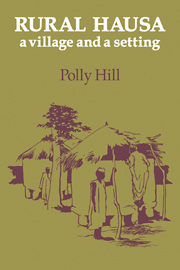Book contents
- Frontmatter
- Contents
- List of tables
- List of illustrations
- Preface
- List of abbreviations and conventions
- Map of Hausaland (after Morgan and Pugh, 1969)
- I Introduction
- II Batagarawa
- III Fathers and sons in gandu
- IV The evidence for economic inequality
- V Further aspects of inequality
- VI The sale of manured farmland
- VII Migration
- VIII Farm-labouring
- IX Local trade in grains and groundnuts
- X Individual poverty
- XI Individual viability
- XII Short-term stability
- XIII The absence of ‘class’
- XIV Concluding speculations
- Commentary, including Hausa glossary
- Bibliography
- Index
XIII - The absence of ‘class’
Published online by Cambridge University Press: 05 May 2010
- Frontmatter
- Contents
- List of tables
- List of illustrations
- Preface
- List of abbreviations and conventions
- Map of Hausaland (after Morgan and Pugh, 1969)
- I Introduction
- II Batagarawa
- III Fathers and sons in gandu
- IV The evidence for economic inequality
- V Further aspects of inequality
- VI The sale of manured farmland
- VII Migration
- VIII Farm-labouring
- IX Local trade in grains and groundnuts
- X Individual poverty
- XI Individual viability
- XII Short-term stability
- XIII The absence of ‘class’
- XIV Concluding speculations
- Commentary, including Hausa glossary
- Bibliography
- Index
Summary
However stable the pattern of economic-grouping in the short run, it does not follow that there is sufficient long-term stability to justify regarding the community as actually, or even incipiently, ‘class-stratified’ in any conventional understanding of this term. In a society in which neither labour nor land is scarce, where there is no slavery or serfdom, or landowning or landless groups, where there are no craft guilds, and where little physical property of any value (other than manured farmland, houses and granaries) escapes sale on the death of its owner – in such a society it would be necessary to call on very special circumstances in support of any case for the existence of economic stratification. Rural West African society being commonly ‘classless’, the onus of proof lies on those who would find this village a special case.
The general conviction that rural Hausa are somehow ‘different’ rests, of course, on a belief in the significance of status-stratification, which derives almost entirely from the early work of M. G. Smith. In his Hausa Communities of Zaria Smith had listed (1955, p. 16) various ‘occupational classes’ in eleven grades in order of prestige (girma). Aristocrats by birth and by appointment came first and second, followed by Malams (and Koranic students) and ‘successful merchants’ (attajirai); then came craftsmen (rnasu sana'a) – other than those to be mentioned – and ‘smaller traders’ (bracketed fifth), brokers (dillalai) and ‘farmers with unimportant subsidiary occupations’ (seventh); finally came blacksmiths, hunters, musicians, with butchers bring up the rear.
- Type
- Chapter
- Information
- Rural HausaA Village and a Setting, pp. 175 - 188Publisher: Cambridge University PressPrint publication year: 1972

